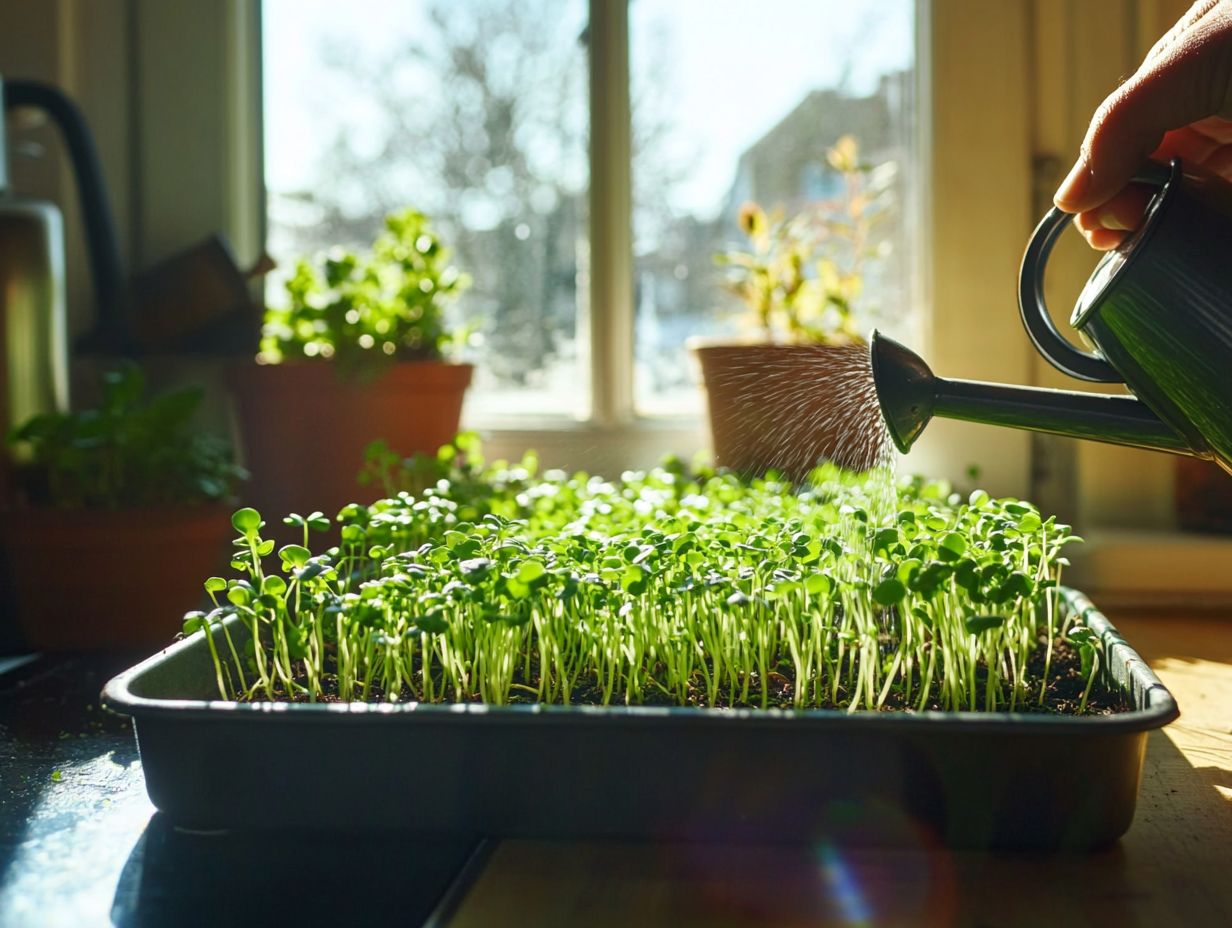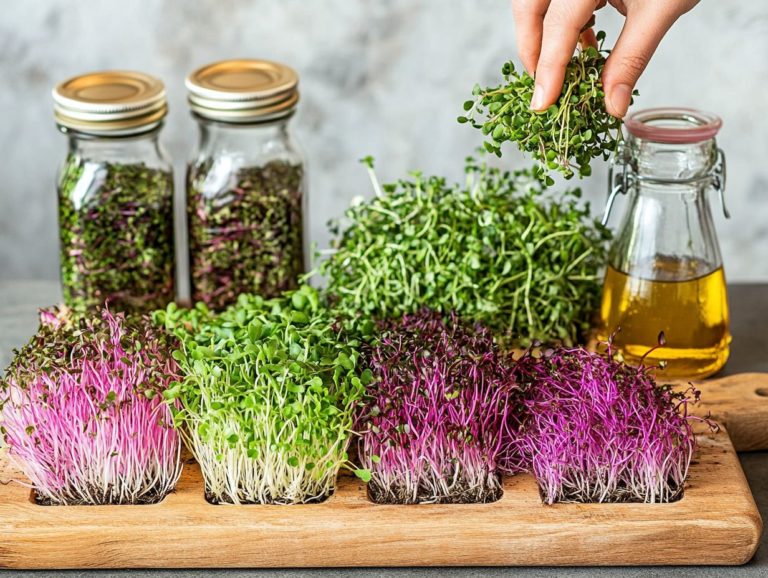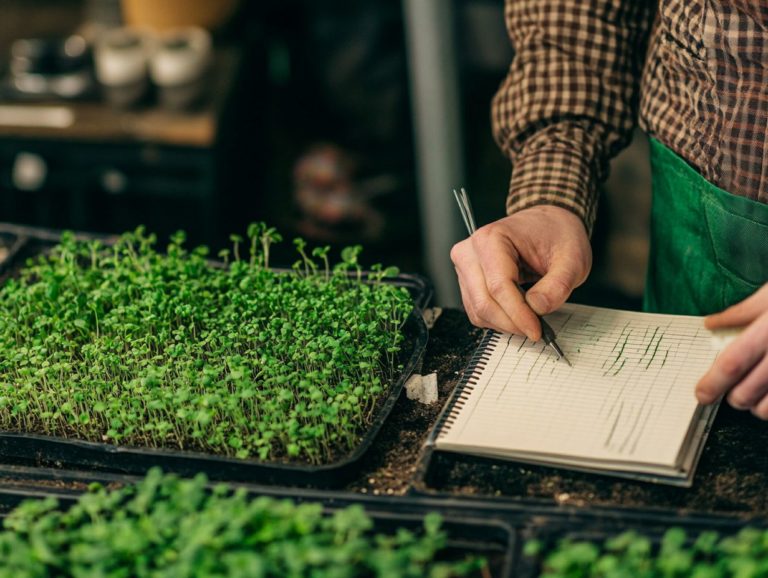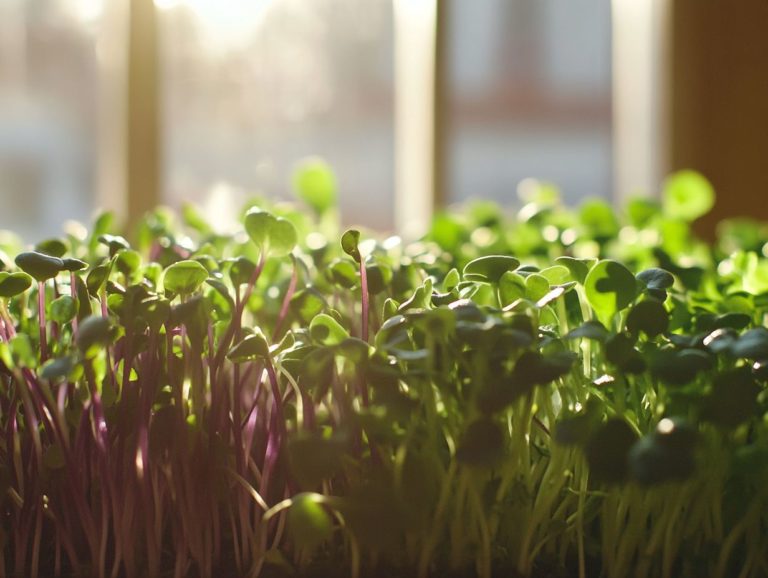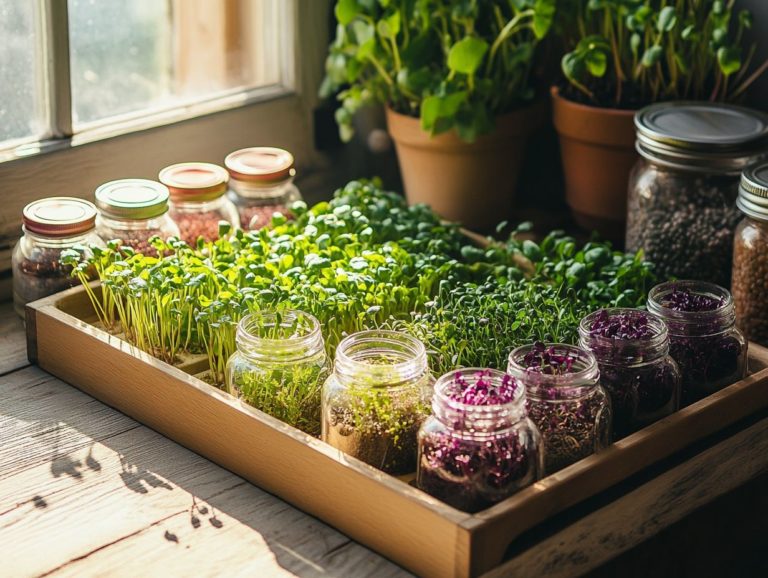How to Water Microgreens Effectively
Microgreens are tiny, nutrient-rich plants taking the culinary world by storm! They brighten your dishes with vibrant flavors and pack incredible nutritional benefits.
Successfully growing these greens requires more than just seeds and soil. Proper watering is crucial for their growth and overall health.
This article delves into the significance of watering microgreens. We outline best practices to ensure they thrive, common pitfalls to avoid, and handy troubleshooting tips for any issues you might encounter.
Dive in to uncover the secrets of cultivating your microgreens with precision and care!
Contents
- Key Takeaways:
- What are Microgreens?
- Why Watering Microgreens is Important
- Best Practices for Watering Microgreens
- Common Mistakes to Avoid
- Troubleshooting Watering Issues
- Frequently Asked Questions
- What are microgreens and why is it important to water them effectively?
- How often should I water my microgreens?
- What is the best way to water microgreens effectively?
- Can I use a spray bottle to water my microgreens?
- How do I know if I am overwatering my microgreens?
- What is the best time of day to water microgreens?
Key Takeaways:
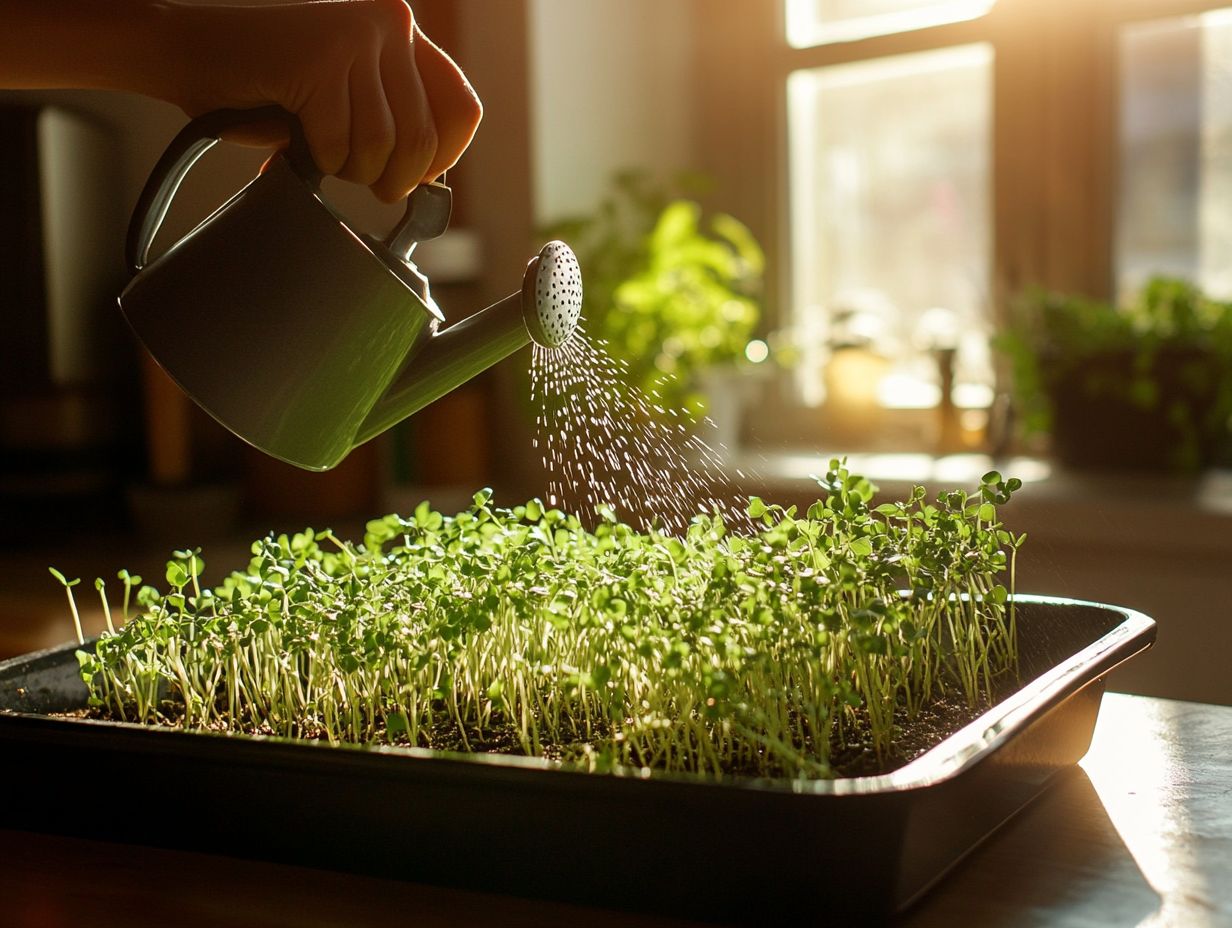
- Proper watering is crucial for the growth and nutritional value of microgreens.
- The best practices for watering microgreens include consistent timing and frequency, as well as using appropriate methods.
- Avoid common mistakes like over or under watering to ensure healthy microgreens.
What are Microgreens?
Microgreens are young, edible plants that you can harvest at an early stage, usually within 7 to 21 days after the seeds sprout. They re packed with nutrients and flavor, making them a sought-after choice for home gardening enthusiasts.
These petite greens can be easily cultivated in various growing media, including coir or peat moss. With the right growing conditions, they thrive beautifully, contributing to their increasing popularity as the go-to ingredient for salads, garnishes, and smoothies.
Definition and Benefits
Microgreens are delightful young vegetable greens you harvest just after the first true leaves unfold. They offer a burst of flavor and an impressive array of health benefits.
These tiny powerhouses are brimming with nutrients, often boasting up to 40 times more vitamins and minerals than their fully grown counterparts. Incorporating them into your daily meals enhances the flavor profile and significantly boosts the nutritional value of your dishes.
If you love gardening, growing microgreens is an easy and rewarding venture. A simple sprinkle of these vibrant greens on salads, sandwiches, or soups can elevate both taste and health benefits. If you’re wondering how to water microgreens properly, you’ll find that they are an incredibly versatile addition to your diet.
Why Watering Microgreens is Important
Watering microgreens effectively is essential for their growth, as it directly influences germination, nutrient absorption, and the overall health of the plants. This attention to detail ensures a thriving crop of these vibrant greens.
Understand the best watering techniques and maintain optimal moisture levels. This promotes robust root systems and enhances air circulation, contributing to the lushness and vitality of your microgreens throughout both the germination and growth phases.
Role of Water in Growth and Nutrition
Water is essential for the growth and nutrition of microgreens, playing a critical role in nutrient absorption and creating the optimal environment for vigorous development.
The quality of the water you use, especially its pH levels (a measure of how acidic or basic the water is) and chlorine content, can significantly impact the health and flavor of these delicate plants. An ideal pH range ensures that nutrients remain accessible, allowing your microgreens to thrive. If you’re looking to preserve their quality, consider exploring the best methods for storing microgreens. On the other hand, high chlorine levels can harm beneficial microorganisms in the soil, vital for nutrient cycling and overall growth potential.
But it doesn’t stop at water quality. Proper soil temperature and moisture levels are equally important. For instance, warm and consistently moist soil fosters germination, while excessively wet conditions can invite disease. Understanding the impact of water quality on microgreens is also crucial. By carefully managing these elements, you can cultivate vibrant and nutrient-rich microgreens that stand out in flavor and quality.
Best Practices for Watering Microgreens

Embracing best practices for watering microgreens is crucial for fostering their healthy growth. It s important to recognize that these practices can differ depending on the watering methods you choose be it bottom watering, top watering, or even flood and drain techniques. Each approach offers unique benefits that can significantly impact the vitality of your microgreens.
Timing and Frequency
The timing and frequency of watering your microgreens are critical elements that can greatly affect their growth. Many gardeners find that daily mistings help maintain consistent wetness.
The ideal watering frequency can vary widely, depending on the specific microgreen variety and the environmental conditions in which they thrive. For example, delicate sprouts like basil and radish often benefit from lighter, more frequent sprays, while hardier varieties such as pea shoots tend to tolerate less frequent watering. To learn how to properly sow different types of microgreens, check out this step-by-step guide to sowing microgreens.
Factors like humidity, temperature, and the type of growing medium you use can greatly influence how often you should irrigate. Keeping the right wetness not only fosters healthy sprouting but also wards off potential issues like mold and mildew that may emerge from overly damp conditions. If you do encounter wilted microgreens, learning the best ways to revive wilted microgreens can also help. By adjusting your watering routine to these variables, you can ensure robust growth while minimizing the likelihood of disease.
Methods and Techniques
Several effective methods and techniques for watering microgreens are at your disposal, including bottom watering, top watering, and the flood and drain method. Understanding these methods can significantly enhance the health and yield of your delicate plants.
Bottom watering allows the roots to absorb moisture directly from the growing medium, minimizing the risk of over-saturation on the leaves, which may cause mold to grow, putting your greens at risk! On the other hand, top watering also provides a convenient and swift hydration option while ensuring even coverage across the greens. For those interested in enhancing their methods, exploring innovative methods for hydroponic microgreens can be beneficial.
The flood and drain method, often favored in hydroponics (a method of growing plants without soil), expertly regulates wetness. You can even utilize household items like pump sprayers to distribute water evenly and maintain optimal conditions. Each technique, such as those outlined in watering techniques for thriving microgreens, can be tailored to meet the specific needs of your greens, ensuring they thrive with just the right amount of hydration.
Common Mistakes to Avoid
Common mistakes in watering microgreens, such as overwatering or underwatering, can seriously undermine their growth and may even lead to problems like mold. This highlights just how crucial it is for you to stick to proper watering guidelines.
Over and Underwatering
Overwatering and underwatering are two common pitfalls that can threaten the health of your microgreens, potentially leading to stunted growth or even root rot if not addressed with care. These issues often arise from a misunderstanding of the specific moisture requirements for different microgreen varieties.
If you notice yellowing leaves and mushy stems, it’s a clear sign of overwatering, as excess moisture suffocates the roots and paves the way for fungal diseases. Conversely, if your microgreens exhibit droopy leaves and dry, brittle tops, pay attention; your plants may not be getting the hydration they need. For more insights on maintaining your microgreens, check out these tips for washing and storing microgreens.
To maintain the perfect moisture balance, regularly check the top inch of soil; it should feel slightly damp, but definitely not soggy. Using a moisture meter can offer precise readings, allowing you to fine-tune your watering schedule and safeguard the health of your root systems as well as the overall vitality of your plants. For more information, explore best practices for microgreen growth.
Using the Wrong Type of Water
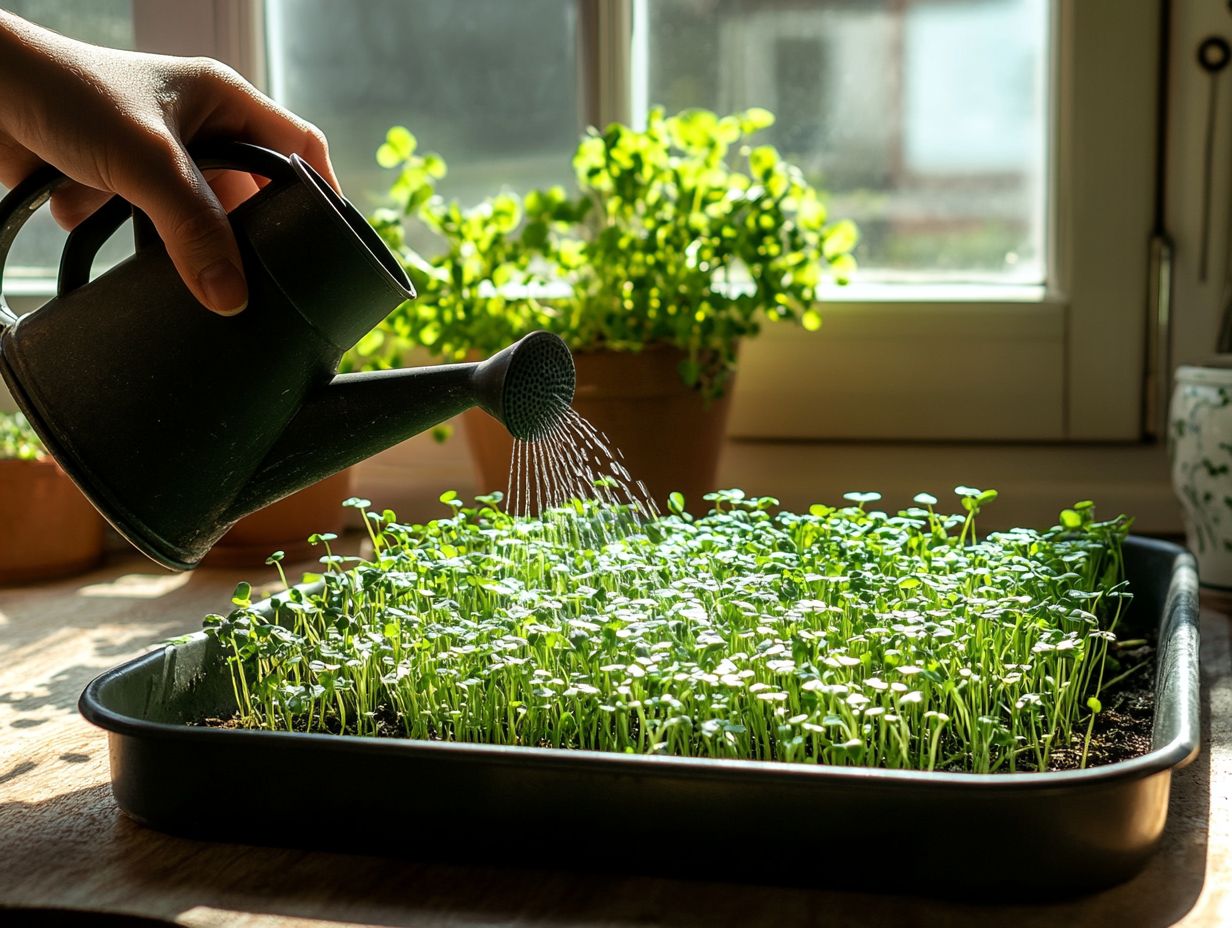
Using the wrong type of water, like tap water loaded with chlorine, can have a detrimental effect on your microgreens. It s essential to grasp the significance of water quality and pH control.
The water you choose plays a crucial role in germination rates and overall growth. Microgreens are particularly sensitive to both chemical and biological contaminants.
Opting for reverse osmosis water, which is water that has been purified by removing impurities, can be especially advantageous. This purified water allows you to exert better control over pH levels critical for effective nutrient absorption and ensuring best growth.
When you prioritize water quality and maintain the ideal pH, you re setting yourself up for healthier, more vigorous microgreens. This attention to detail ultimately enhances both yield and flavor in your crops.
Troubleshooting Watering Issues
Effectively troubleshooting watering issues can be the key to safeguarding your crop of microgreens. Improper moisture levels, mold, or other environmental factors can impact their health.
By addressing these challenges proactively, you ensure thriving growth and a bountiful harvest.
Identifying and Addressing Problems
Identifying and addressing watering issues in microgreens is vital for nurturing healthy plants. Moisture levels are a critical factor to monitor closely throughout their growth phases, especially during the germination stage.
To effectively troubleshoot concerns like wilting leaves, discoloration, or the unwelcome emergence of mold, start by inspecting the soil’s moisture content. A gentle touch to the soil surface can reveal whether it feels overly dry or soggy.
If the soil feels too dry or soggy, make necessary adjustments using appropriate watering methods. Environmental factors such as ambient humidity and light exposure also play significant roles in this delicate balance.
Excessive humidity can lead to mold growth, so improved air movement is essential. Be mindful to provide your microgreens with adequate light intensity while steering clear of direct, harsh rays, as these can induce stress.
Keep a close eye on these factors, including the soil composition and watering frequency. You can intervene promptly, ensuring robust microgreen growth and a rewarding harvest.
Frequently Asked Questions
-
What are microgreens and why is it important to water them effectively?
Microgreens are young and tender greens harvested at an early stage of growth. They are packed with nutrient-dense greens and are popularly used in salads, sandwiches, and smoothies.
It is important to water microgreens effectively as they have delicate root systems and need proper hydration for optimal growth.
-
How often should I water my microgreens?
The frequency of watering your microgreens depends on various factors such as climate, type of microgreen varieties, and the type of growing media. In general, microgreens require watering once a day.
However, in hot and dry climates, they may need to be watered twice a day to maintain optimal conditions.
-
What is the best way to water microgreens effectively?
The most effective way to water microgreens is from the bottom, commonly referred to as bottom watering. Fill a tray or container with water and place the microgreen tray on top.
This allows the water to be absorbed from the bottom up, ensuring that the entire root system is properly hydrated, promoting healthy growth.
-
Can I use a spray bottle to water my microgreens?
Yes, you can use a spray bottle to water your microgreens. However, this method is not as effective as bottom watering, as the water may not reach the bottom of the root system.
If using a spray bottle, consider using it in conjunction with daily mistings to maintain adequate moisture without overwatering.
Don t wait! Start watering your microgreens correctly today for the best harvest!
How do I know if I am overwatering my microgreens?
Many people accidentally overwater their microgreens. Look for yellow leaves, slow growth, and mold on top of the soil. These are signs that you might be overwatering.
If you notice any of these signs, reduce how often you water.
What is the best time of day to water microgreens?
Water your microgreens in the morning. This allows them to absorb water and nutrients throughout the day.
Avoid watering in the evening. This can create excess moisture that leads to mold and diseases. Keep your microgreens healthy and thriving by watering them at the right time!

